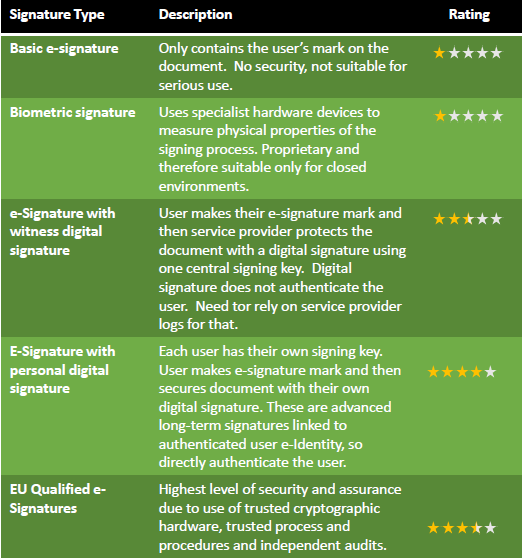One of the most confusing aspects for an organisation wanting to choose an eSignature solution is understanding the jargon that providers use. There are many eSignature schemes in the market, with major differences in terms of security and trust.
However, there is a lot of documentation explaining the differences and that can cause confusion. This makes comparing and assessing their suitability in business processes even harder.
Thanks to our eSignature expertise, we developed the high-level eBook "Choosing the right type of eSignature". It offers key information to help business managers understand the types of online signatures that exist.
In this blog, we walk you through the path of choosing the right eSignature for your business.
Understanding eSignatures
1. The different ways of signing documents online
In our research, we have analysed the following common eSignatures types:
- Basic eSignature marks
- Biometric eSignatures
- eSignatures with witness digital signatures
- eSignatures with unique digital signatures (advanced electronic signatures)
- EU Qualified eSignatures (or their equivalent in various global locations)
2. Criteria for rating eSignatures
The research discusses each of these electronic signature types, considering how they work and the security and trust they provide. We also look at their legal acceptance in a court of law and how difficult they could be to deny the validity of.
It's important to remember usability and commercial issues. We have also analysed the ease of use, ability to work with different systems and costs of each of the above types. A simple star rating scheme is used for easy analysis.
3. Results and conclusions
Our high-level results and conclusions are as follows:
For our full analysis of these electronic signatures, download our free Choosing the right type of eSignature eBook.
The eBook will help you to understand the different concepts and then perform a risk-based approach to determine which is right for your business. As a result, you won’t get caught out by implementing a solution which is not fit for purpose.
Remember, change is the one constant in business processes. As soon as you deploy an eSignature solution for one purpose, another business requirement will emerge. Therefore, it is important to choose an eSignature solution that supports your needs today and also in the future.
Having determined the right type of signing solution for your business, the next step is finding which is the most appropriate for your requirements. To help you in this process, we have another eBook which provides questions to ask suppliers: download The ultimate guide to comparing electronic signature solutions today.



